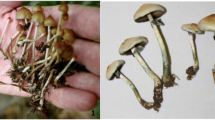Abstract
Botanical preparations used by shamans in rituals for divination, prophecy, and ecstasy contain widely different psychoactive compounds, which are incorrectly classified under a single denomination such as “hallucinogens,” “psychedelics,” or “entheogens.” Based on extensive ethnopharmacological search, I proposed a psychopharmacological classification of magic plants in 1979. This paper re-evaluates this taxonomy in the context of consciousness research. Several groups of psychodysleptic magic plants are proposed: (1) hallucinogens—psilocybin mushrooms, mescaline cacti, dimethyltryptamine snuffs, and the synthetic ergoline lysergic acid diethylamide induce strong perceptual changes, affective intensification, and cognitive enhancement. Their ethnobotanical uses include long lasting divination rituals, prophecy, and sacramental practice. (2) Trance-inducers—ergoline Convolvulaceae and South American Banisteriopsis produce quietness, abstraction, lethargy, mild sensorial and cognitive changes, and salient visual imagery changes used in trance rituals and specific divination practices. (3) Cognodysleptics—marijuana (tetrahydrocannabinol) and other terpene-containing plants induce changes in thought, imagination, and affective functions and are used in short-term divination or oneiromancy. (4) Deliriants—tropane-containing Solanaceae, wild tobacco, and Amanita muscaria (muscimol) induce a delirium characterized by dim and clouded consciousness, stupor, confusion, disorientation, perception distortion, difficulties in recollection, anxiety, irritability, excitation, and behavioral disorganization employed in sorcery, purification, or exorcism rituals. The core mental effects required for a drug to be used in shamanistic rituals include light-headedness, enhanced imagery, and experience intensification. This constellation was the reason why, in his classification of psychoactive compounds, the pioneer German psychopharmacologist Louis Lewin established in 1924 a group of drugs under the appropriate name of Phantastica.
Similar content being viewed by others
References
Aghajanian, G. K., & Marek, G. J. (1999). Serotonin and hallucinogens. Neuropsychopharmacology, 21, 16S–23S.
Díaz, J. L. (editor) (1975). Etnofarmacología de las plantas alucinógenas latinoamericanas. México: Centro Mexicano de Estudios en Farmacodependencia (p. 223). Editorial Libros de México.
Díaz, J. L. (1977). Ethnopharmacology of sacred psychoactive plants used by the indians of Mexico. Annual Review of Pharmacology & Toxicology, 17, 647–675.
Díaz, J. L. (1979). Ethnopharmacology and taxonomy of Mexican psychodysleptic plants. Journal of Psychedelic Drugs, 11, 71–101.
Díaz, J. L. (1989). Plantas Mágicas y Sagradas de México. In: Psicobiología y Conducta (pp 106–145). México City: Fondo de Cultura Económica.
Díaz, J. L. (2003). Las plantas mágicas y la conciencia visionaria. Arqueología Mexicana, X(59), 18–25.
Díaz, J. L. (2007). La conciencia viviente. México: Fondo de Cultura Económica.
Fisher, R. (1971). A cartography of the ecstatic and meditative states. Science, 174, 897–904.
Grof, S. (1980). LSD psychotherapy. New York: Hunter House.
Heim, R., & Wasson, R. G. (1958). Les Chamignons Hallucinogenes du Mexique: Etudes Ethnologiques, Taxonomiques, Biologiques, Physiologiques et Chimiques. Paris: Editions du Muséum National d´Histoire Naturelle.
Huxley, A. (1954). The doors of perception. New York: Harper & Row.
James, W. (1900/1974). The varieties of religious experience. London: Fontana.
Klüver, H. (1966). Mescal and mechanisms of hallucinations. Chicago: University of Chicago Press.
Lanteri-Laura, G. (1994). Las alucinaciones. México: Fondo de Cultura Económica.
Laski, M. (1961). Ecstasy in secular and religious experiences. Los Angeles: Tarcher.
Lewin, L. (1964). Phantastica. Narcotic and stimulating drugs, their use and abuse. New York: E.P. Dutton & Co. First edition in German, 1924.
Osmond, H., Smythies, J., & Harley-Mason, I. (1952). Schizophrenia: a new approach. Journal of Mental Science, 98, 309–315.
Schultes, R. E. (1992). Plantas de los Dioses. México City: Fondo de Cultura Económica.
Shanon, B. (2003). The antipodes of the mind: charting the phenomenology of the ayahuasca experience. London: Oxford University Press.
Siegel, R. K. (1977). Hallucinations. Scientific American, 237, 132–140.
Siegel, R. K. (1989). Intoxication: life in pursuit of artificial paradise. New York: Dutton.
Siegel, R. K. (1992). Fire in the brain: clinical tales of hallucination. New York: Dutton.
Smith, A. L., & Tart, C. T. (1998). Cosmic consciousness experience and psychedelic experiences: a first person comparison. Journal of Consciousness Studies, 5, 97–107.
Tart, C. T. (1972). States of consciousness and state-specific sciences. Science, 176, 1203–1210.
Wasson, R. G. (1980). The wondrous mushroom; Mycolatry in Mesoamerica. New York: McGraw & Hill.
Author information
Authors and Affiliations
Corresponding author
Rights and permissions
About this article
Cite this article
Díaz, J.L. Sacred plants and visionary consciousness. Phenom Cogn Sci 9, 159–170 (2010). https://doi.org/10.1007/s11097-010-9157-z
Published:
Issue Date:
DOI: https://doi.org/10.1007/s11097-010-9157-z




